Perfecting your form for squats can feel like solving a puzzle.
You know something isn’t quite right, but no matter how much you tweak your stance, back angle, and bar position, it still feels off.
For many squatters, the key to going from good squat technique to picture-perfect form is mastering a few simple squat cues.
In this article, I’ll share 9 of my favorite barbell back squat cues to help you perfect your squat form, rep after rep.
Want to know exactly how you should train to reach your fitness goals? Take our free 60-second training quiz and find out now.
- The 9 Best Squat Cues for Perfect Squat Form
- 1. Lift the Boulder
- 2. Eyes on the Horizon
- 3. Claw the Floor
- 4. Elbows in Your Pockets
- 5. Ribs Down
- 6. Buckle to Heels
- 7. Drive Your Back into the Bar
- 8. Explode from the Hole
- 9. Spread the Floor
- Supplements to Maximize Gains from Squat Training
Table of Contents
+The 9 Best Squat Cues for Perfect Squat Form
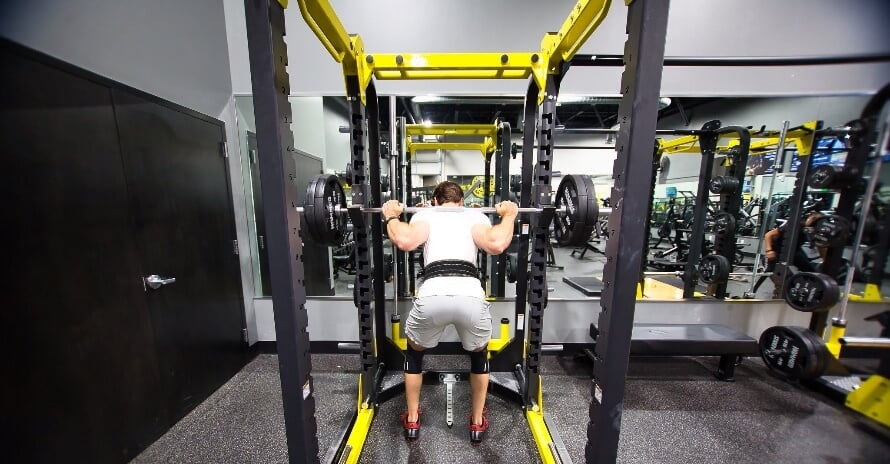
1. Lift the Boulder
When to Use: Just before unracking the barbell.
Why it Works: A common mistake when squatting is only engaging the muscles the bar touches—the rear delts and traps. To squat heavy weights safely, though, you need your entire back involved. Only then can you properly support and balance the load.
Imagining the bar as a boulder covering your entire back helps you engage every muscle from top to bottom, which reduces injury risk and allows you to lift heavier weights.
2. Eyes on the Horizon
When to Use: Throughout each set.
Why it Works: Maintaining proper squat form with a bar on your back becomes tough if you tend to look downward. Looking at your feet can pull your chest down, round your back, and drag you off balance. A reliable back squat coaching cue to stay upright and stable is to fix your eyes on the horizon.
Just be careful not to tilt your head back—”the horizon” works, but “the stars” are too high.
3. Claw the Floor
When to use: Throughout each set.
Why it works: While it’s safe for your knees to pass your toes during squats, allowing them to pitch too far forward can cause your heels to lift, which shifts your center of gravity and increases injury risk.
A solid coaching cue for squatting without this issue is to “claw the floor.” Imagining pulling your big toe, pinky toe, and heel toward the center of your sole activates the muscles in your feet and lower legs, and creates a stable base for lifting heavy weights.
Here’s an illustration to help you visualize this:
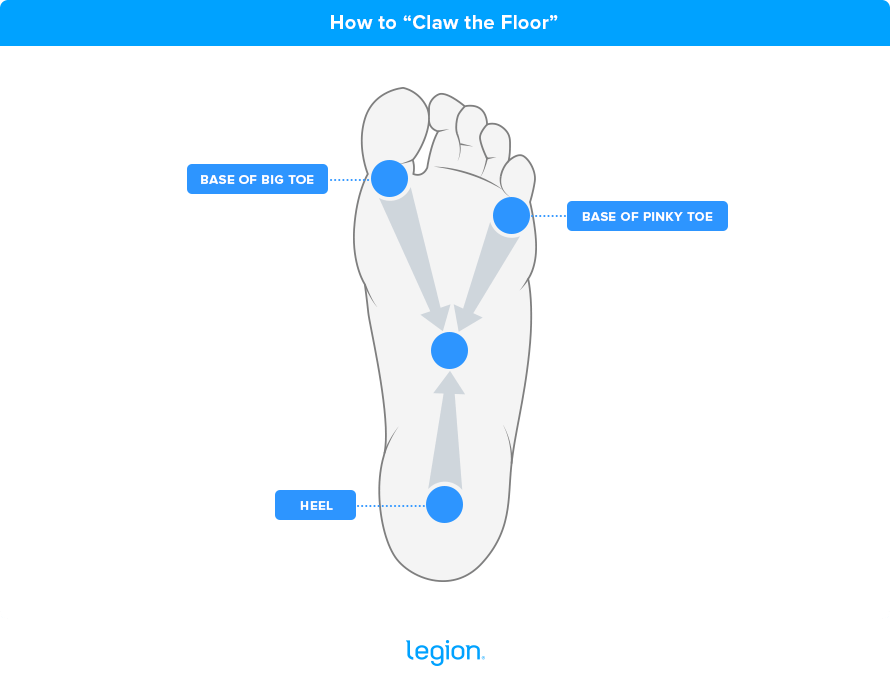
4. Elbows in Your Pockets
When to use: Throughout each set.
Why it works: To support heavy weights and maintain proper squat form, you need to engage your entire back. But some find firing up the lats tricky. A useful squat coaching cue for these folks is to imagine putting your elbows in your back pockets.
Using the squat cue “bend the bar” can also work, though some people dislike it because it can make you tip forward. “Elbows in pockets” keeps your upper back tight without disrupting your form, which is why I prefer it.
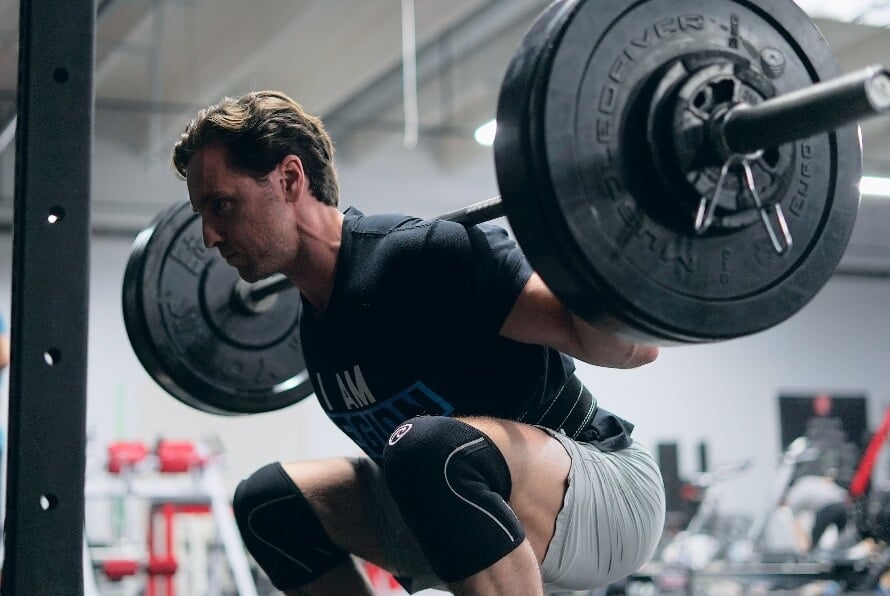
5. Ribs Down
When to use: Throughout each set. You’ll need to reset it every time you take a “belly breath” and brace.
Why it works: Avoid stressing your lower back by pulling your sternum and belly button closer together using the cue “ribs down.” This keeps your spine in a safe, neutral position, which helps you lift heavier weights safely and efficiently.
RELATED: The Complete Guide to the Valsalva Maneuver
6. Buckle to Heels
When to use: As you descend.
Why it works: “Push your hips back” is a common back squat coaching cue intended to help squatters maintain balance and proper torso angle. If your torso or femur lengths differ from the average, however, it can actually have the opposite effect.
A better squat cue is to imagine bringing your belt buckle (real or imaginary) toward your heels. This works regardless of your anatomy, so no matter your body type, it boosts your balance. Here’s an illustration to help you visualize this:
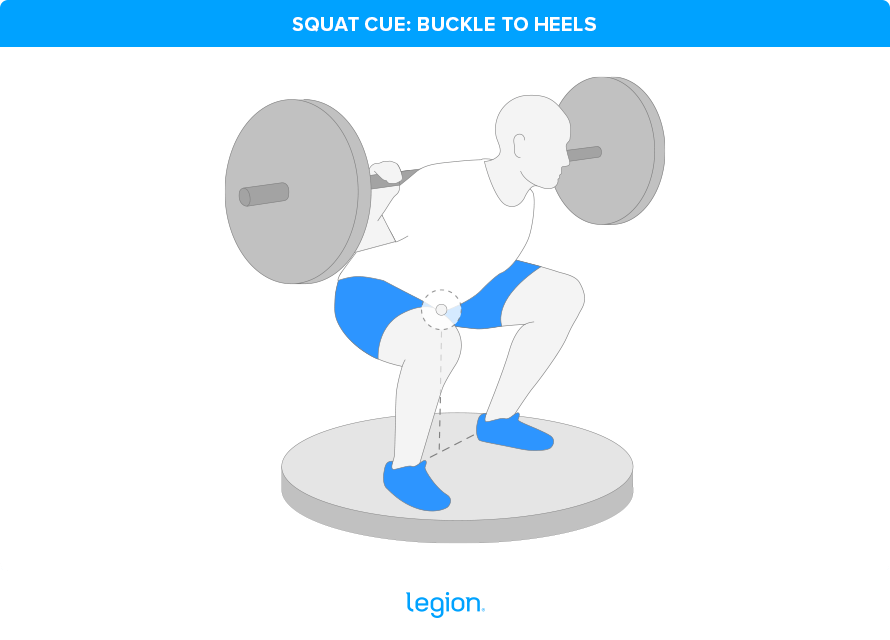
7. Drive Your Back into the Bar
When to Use: As you ascend.
Why it Works: Forcefully driving your back into the bar as you begin standing up prevents you from leaning too far forward, which helps you lift the weight more efficiently.
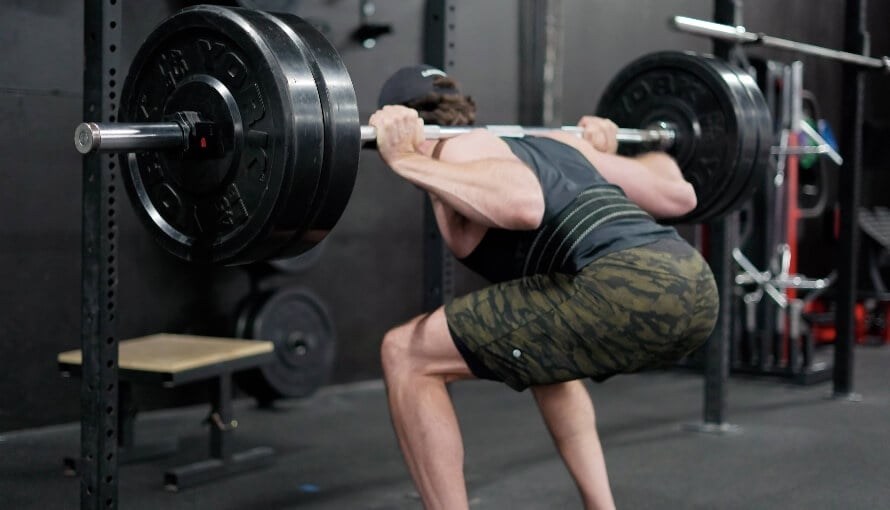
8. Explode from the Hole
When to Use: As you ascend.
Why it Works: The hardest part of each rep for most squatters is just after they come out of “the hole,” when their legs are slightly above parallel. The cue “explode from the hole” reminds you to drive upward forcefully from the bottom, push through the “sticking point,” and complete the rep powerfully.
9. Spread the Floor
When to Use: As you ascend.
Why it Works: If your knees cave inward as you stand up in the squat, imagine spreading the floor apart with your feet. While your feet won’t actually move, thinking about driving them outward helps keep your knees in line with your toes, engages your glutes, and enables you to lift more weight with a lower risk of pain or injury.
Supplements to Maximize Gains from Squat Training
Dialing in your squat cues is a powerful way to lift heavier, but if you want to get the most out of your training, consider these three supplements:
- Protein powder: Protein powder, such as Whey+ (Legion’s whey isolate) or Casein+ (Legion’s micellar casein), provides your body with the nutrients needed to build muscle tissue and recover from workouts.
- Creatine: Creatine boosts muscle and strength gain, improves anaerobic endurance, and reduces muscle damage and soreness from your workouts. For a natural source of creatine, try Legion’s creatine monohydrate, creatine gummies, or post-workout Recharge.
- Pre-workout: A high-quality pre-workout enhances energy, mood, and focus, increases strength and endurance, and reduces fatigue. For a top-tier pre-workout containing clinically effective doses of 6 science-backed ingredients, try Legion’s Pulse with caffeine or without.
(If you’d like even more specific advice about which supplements you should take to reach your health and fitness goals, take the Legion Supplement Finder Quiz, and in less than a minute, you’ll know exactly what supplements are right for you.)
Scientific References +
- Yavuz, Hasan U., and Deniz Erdag. “Kinematic and Electromyographic Activity Changes during Back Squat with Submaximal and Maximal Loading.” Applied Bionics and Biomechanics, vol. 2017, 2017, pp. 1–8, https://doi.org/10.1155/2017/9084725.
- Larsen, Stian , et al. New Insights about the Sticking Region in Back Squats: An Analysis of Kinematics, Kinetics, and Myoelectric Activity. 7 June 2021, www.frontiersin.org/journals/sports-and-active-living/articles/10.3389/fspor.2021.691459/full, https://doi.org/10.3389/fspor.2021.691459. Accessed 7 June 2021.










